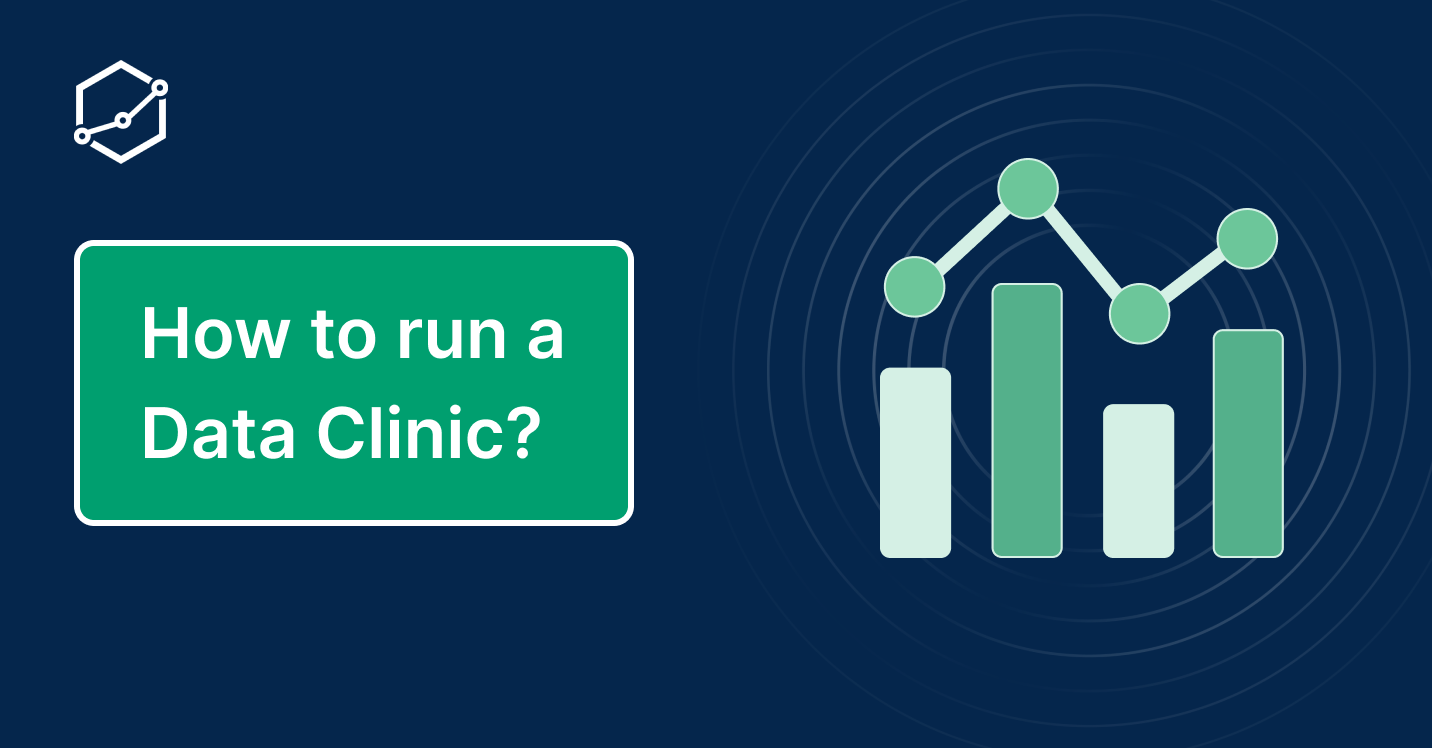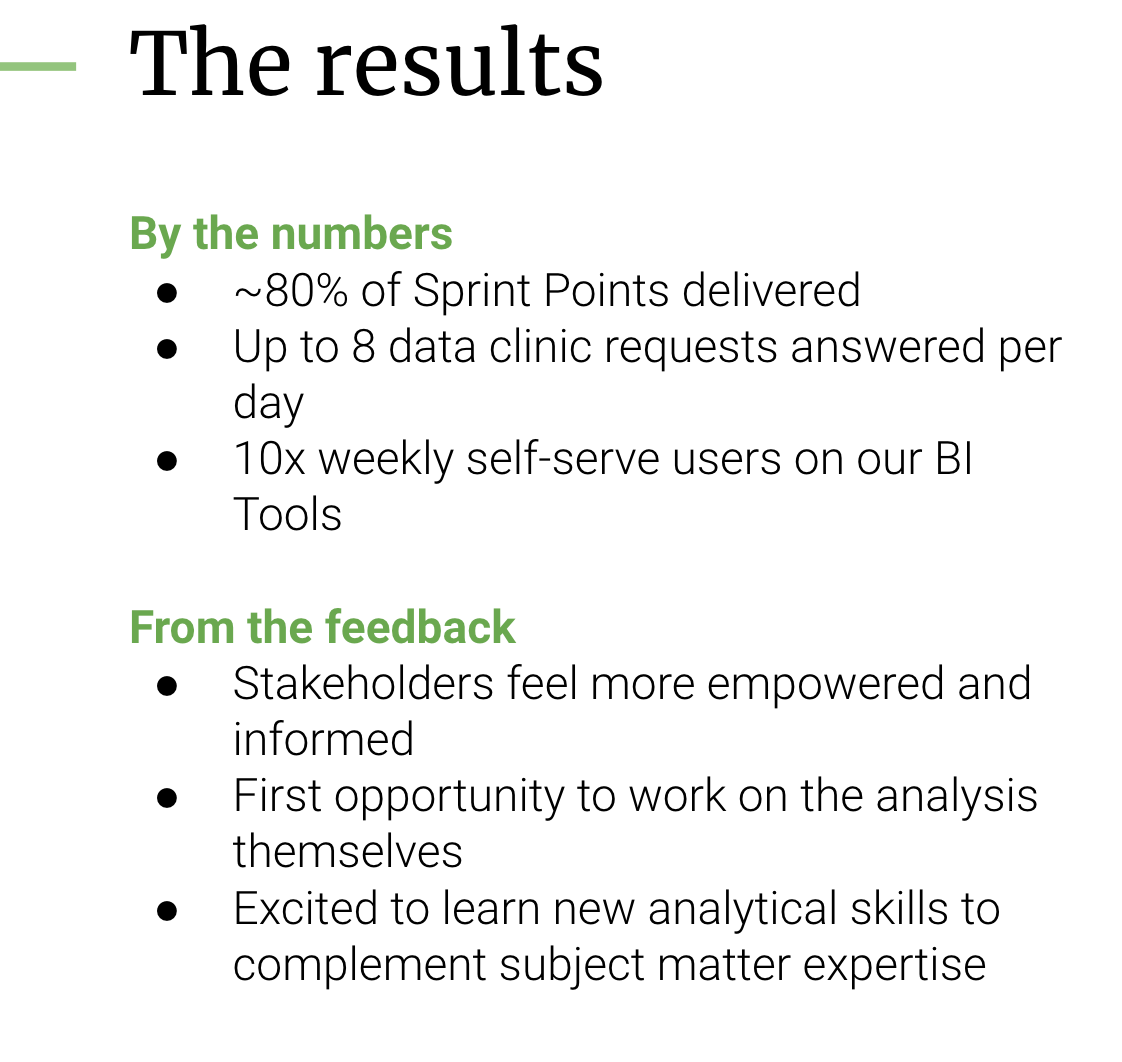How to run a Data Clinic (aka Data Office Hours)
Data clinic is one of many ways you create value and drive your organization toward better data literacy. Here's how.

As data team members, you want people to ask you data questions. Because that’s where you create value and drive your organization toward better data literacy.
But how do you balance between “encouraging people to ask questions” and “being bombarded with questions and getting no real work done”? You may hire more people to answer questions, or try to compute and document every possible question people might have. But that’s just more work stacked up for you - whether it’s hiring more people, or trying to be the prophet of business users’ requests - while those “quick questions” continue to torpedo your way.
One simple yet elegant solution I often see data teams implement is data clinics (a.k.a data office hours).
What Exactly Is A Data Clinic?
A Data Clinic (or data office hour) is a time of the day when you set aside your plan and welcome walk-in requests from business users. You want to create an open space for insights transferring, teaching, and training. There is no fixed rule for how often you should do it - some do it once a week, some twice a week. I’ve seen some do it daily, or even twice daily. It largely depends on your business user’s data maturity and demand.
I call data clinic elegant because it helps data leaders protect their team’s time against a clamor of “quick questions” while allocating a healthy balance between ad-hoc and high-leverage, forward-looking work. It’s one step closer to a full-fledged self-service organization.
And this is no baseless speculation either - various data leaders already had success with data clinics. In a slide deck shared with dbt Slack community, Jacob from Montreal Analytics showed that with data clinic, the number of self-serve business users on their BI tool is tenfold - among other positive results.

How To Run A Data Clinic?
Set Up A Public Slack Channel for Data Requests
First - if you don’t have this already then you should - set up a public Slack channel where people can tunnel in their data questions. You should know the questions beforehand to prepare the required datasets - otherwise, you might sputter away the time on performing data pull or transformation just to get the base data.
Of course, it’s fine for people to walk in with an impromptu question too, but the chance of getting it answered immediately is lower.
Depending on the nature of the questions, you can either respond asynchronously or ask them to meet up during Data Clinic: “Hey that’s a great question. Happy to work through this during our Data Clinic today at 5 pm. Come see me and let’s chat!”
Teach, Not Serve
Instead of just serving business user requests, use data clinic to teach.
- Teach them how to ask more focused questions - when you see a question that can be framed better.
- Teach them how to get the needed numbers - show how they can do it next time. Show them which dataset to use and explain its data structure. Show them the common fields and explain how they’re created.
- Teach them how to build dashboards, how to add one additional filter, or how to make better use of the self-serve interface. Teach them that extra SQL command they can use to wield some data magic.
- Be aware of their data literacy level so that you can balance your teaching and you giving them what they need. Always remember that they came to you with a question, make sure the question is answered (by you or them) towards the end.
When done right, you’re creating the next host of Data Clinics - the next point person who could help answer others’ data clinic questions.
Engage thoughtfully
Business users have varied data needs and maturity. Some just need dashboards to monitor - ad-hoc data exploration is something out of their vocabulary. Others want to put on their journalist hats and investigate the spike and the dive on dashboards.
Between these two is a spectrum of different maturity and behaviors:
- Users with pent-up data demand but found the BI tools hard to use - so they export data and do on-the-fly analysis on Excel instead.
- Engaged users with new business initiatives that deserved analytics support - but they don’t know or see the value of your team.
- Disengaged users who haven’t identified the need to reach out - they just don’t have experience interacting with the data team.
Understanding the maturity and persona of those you’re talking to will help you determine how to engage them in a thoughtful, progressive manner.
The great thing about data clinic is that it drums up people's confidence. Business users often know what they need - but not what to ask. Without data clinics, these people might not have filed proper data tickets at the cost of looking stupid.
Don’t be discouraged if people don’t come
It takes time before people start coming in.
They might be shy, they might not be used to it, or they just don’t know if their problem can be solved with your help. But sooner or later, when they see their colleagues coming to you, or when they suddenly have a specific data question, they’ll show up.
Make sure you have a backup to-do list to do when no one shows up. Pick small tasks that can be easily disrupted (like updating data docs or training materials). This will help you be consistent with data clinics so that you always have something to do during that time.
If you do your jobs well, after a while people won’t be showing up just as much — or rather, they should show up with much better-framed questions and conversations.
Engage with the disengaged
One doesn’t simply open up a data clinic and engage with those who come. You should also engage with the disengaged: Set up quarterly meetings with these teams to keep up with them, ask them what they’re doing, what their goals are, how they get things done, how the analytics team can help - and get them through the proverbial door of your data clinic.
Data clinic is obviously useful to engaged stakeholders. Why do you need users who haven’t seen the need to reach out?
Because data clinic is not just about answering people’s questions. It’s also about building a culture of self-service where people know they can benefit from asking data-driven questions. The meta-implication is that if you decide the often-repeated recommendation to treat data as a product like you would a real product is good and true, then one way you market a product is that you create awareness and demand for it.
When you treat data as a product, data clinic is how you sell data values.
Benefits of Data Clinic
If done right and consistently, you should see the following benefits within your organization:
- The level of context-switching and interruptions within data teams is greatly reduced. Your data team can spend more time on forward-looking, strategic data initiatives, and less time on ad-hoc requests.
- Data literacy level of your org slowly but steadily increases. More stakeholders can ask the right question, and be able to self-serve the data themselves.
- Your data analyst’s job responsibilities are now transformed. They work in tandem with business users as though-partners and look after the highest value activities for the business.
Data team's most common stumbling block — one that often leads to an underperforming and unmotivated team — is seeing ad-hoc requests with a false dichotomy: Either you completely obliterate it, or you just have to live with it.
Successful implementation of data clinics showed that there is a better way - where ad-hoc can be leveraged for building trust and cultivating interpersonal relationships between your data team and business stakeholders. There is this awesome comment from TJ Murphy on Locally Optimistic that sums it up nicely - and I’ll quote it verbatim here:
“Adhoc is salt, too little or too much is bad, you want just the right amount. Zero ad-hoc most likely means not enough questions are being asked in your org.”
How much is the right amount for you? You might need to hold a data clinic to find out :)
What's happening in the BI world?
Join 30k+ people to get insights from BI practitioners around the globe. In your inbox. Every week. Learn more
No spam, ever. We respect your email privacy. Unsubscribe anytime.

